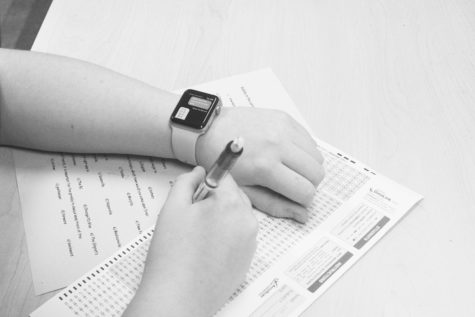Technology enables access to easy cheating

A study by McAfee Inc. showed 62 percent of high schoolers claimed to have witnessed or heard rumors of cheating using technology on an exam. New technology, like Apple watches, has made cheating easier.
As her teacher walked out of the classroom door, freshman Kaitlyn Bowles watched her classmate pull out a smartphone during a class exam, searching for answers online. Having witnessed this multiple times, she thought this was unfair to herself and her classmates, but she did not report the incident.
“I think cheating impacts the student body by allowing students who maybe don’t deserve to get ahead, [succeed] more easily than the ones who actually put in the work,” Bowles said.
In a 2017 study by McAfee Inc., a computer security company, 62 percent of high school students in the United States claimed to have seen or heard of another student using an electronic device to cheat on a test, quiz, project or assignment, while 29 percent admitted to cheating themselves. The study polled 3,902 students in total. In the same study, it was revealed that 40 percent of those who are 14 to 15 years old had seen or heard of classmates cheating with technology, while this percentage increased to 52 percent in those who are 16 to 18 years old.
Gregory Cizek, Guy B. Phillips distinguished professor of educational measurement and evaluation, said in an e-mail that technology has not necessarily invited students to cheat, but it has made some kinds of cheating easier.
Senior Grace Schwandner said she witnessed a student glance down at a smartwatch repeatedly during a test. Schwandner, her classmates and her teacher, noticed the direction of the student’s gaze, and thus the student was called out for his actions.
“I didn’t know if they were just doing it because they didn’t know … how to take the test, or if they were just doing it because they were lazy, but I was surprised that they actually [tried] to use [a smartwatch] while taking the test,” Schwandner said.
According to Cizek, although technology helps implement cheating, it also provides a solution.
“Technology has made detecting cheating easier,” said Cizek. “For example, it’s fairly easy to detect student plagiarism now with either software or simple internet searches or there are companies [like] Turnitin that do it automatically.”
Mary Salvaggio, public relations representative from McAfee Inc., said in an e-mail that one way to promote appropriate technology use is to create contracts which outline rules for usage that are agreed upon by students and teachers.
“It will be increasingly important that continued conversations take place among teachers, students and parents,” said Salvaggio. “Expectations of responsible technology use should be built into … school cultures and address students at all levels.”
According to Bowles, new technology has made cheating more open to students.
“[Recently, I’ve seen] more [cheating] than I’ve witnessed … happening in the other academic environments that I’ve been in, so I feel that [cheating] could be better monitored and controlled,” Bowles said.

